Effectiveness of Waste Audit and Management in Subway, New Zealand
VerifiedAdded on 2023/01/12
|34
|10682
|93
Report
AI Summary
This research report investigates the effectiveness of waste audit and waste management systems within Subway, a prominent subs and salad chain in New Zealand. The study, conducted through qualitative interviews, reveals a significant level of food waste during regular business months, leading to revenue loss. The report examines the current inventory and waste management practices at Subway, assessing the performance of the waste audit system. It reviews relevant literature on inventory and waste management in the food industry, food waste management, and the specific context of food waste in New Zealand. The methodology includes a qualitative approach, focusing on primary data collected through interviews. The findings highlight the ineffectiveness of the existing waste management system in Subway. The report concludes with specific recommendations to improve the system and reduce food waste, aiming to enhance operational efficiency and profitability. The research contributes to understanding how waste audit systems can be optimized in the food industry to address challenges related to inventory and waste management.
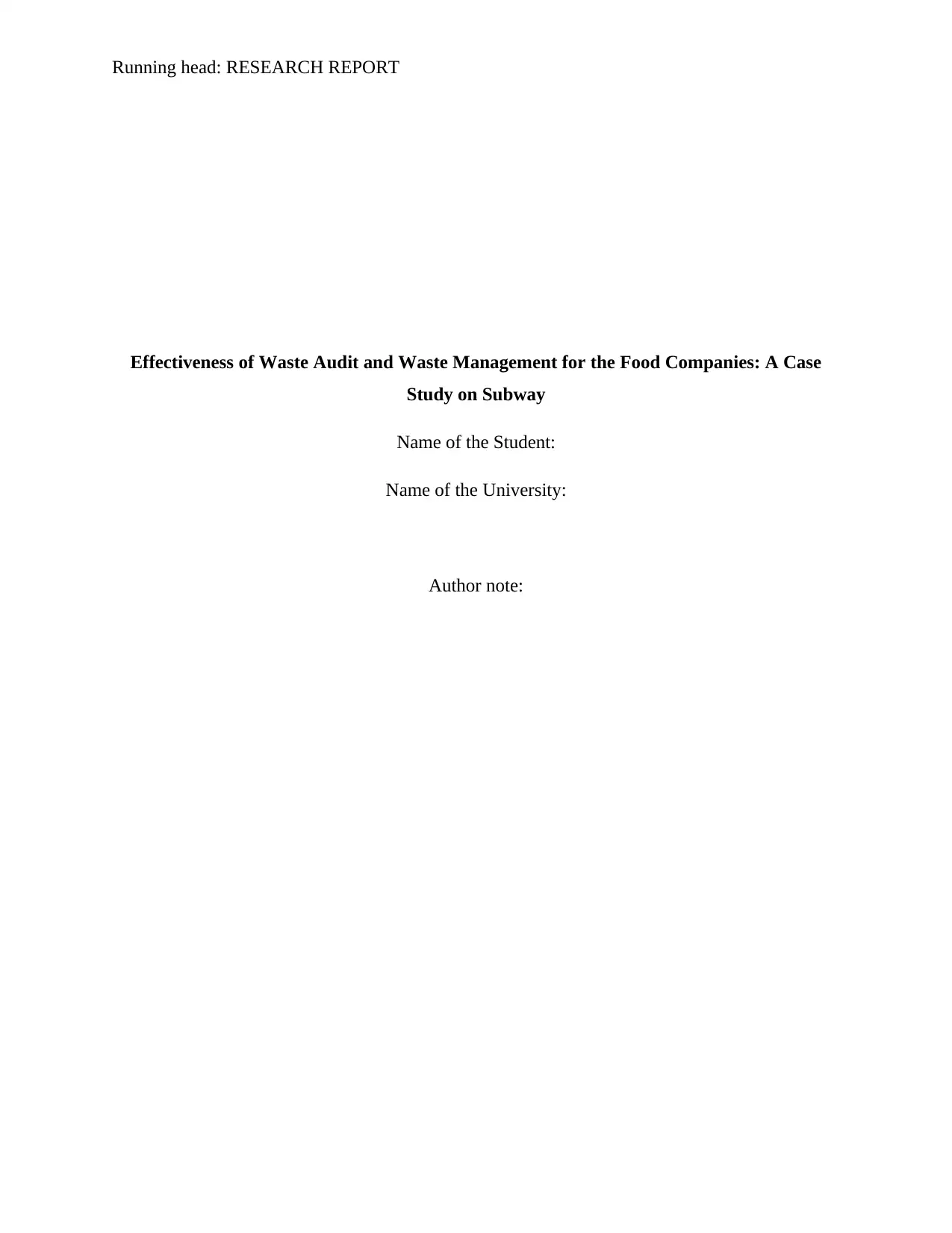
Running head: RESEARCH REPORT
Effectiveness of Waste Audit and Waste Management for the Food Companies: A Case
Study on Subway
Name of the Student:
Name of the University:
Author note:
Effectiveness of Waste Audit and Waste Management for the Food Companies: A Case
Study on Subway
Name of the Student:
Name of the University:
Author note:
Paraphrase This Document
Need a fresh take? Get an instant paraphrase of this document with our AI Paraphraser
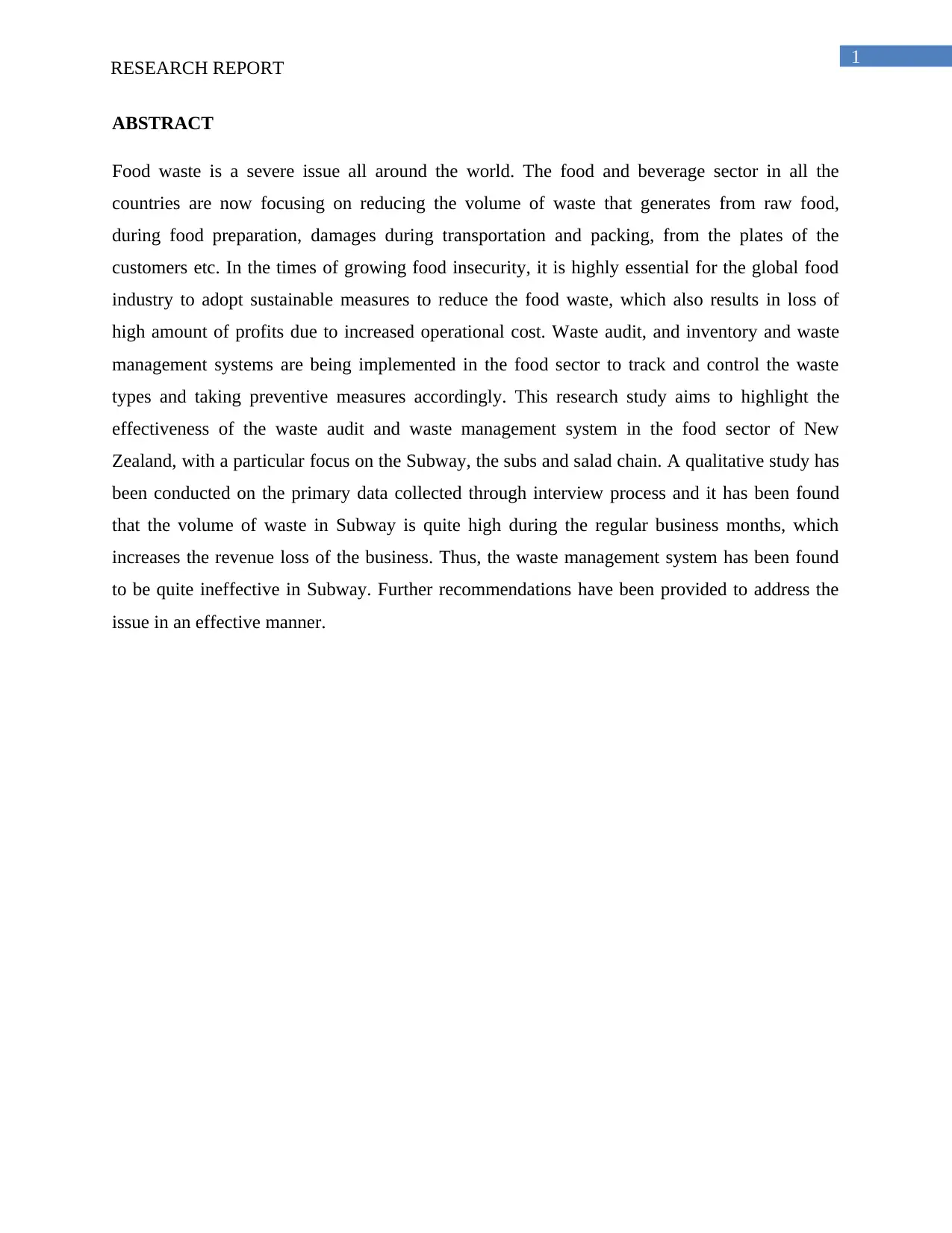
1
RESEARCH REPORT
ABSTRACT
Food waste is a severe issue all around the world. The food and beverage sector in all the
countries are now focusing on reducing the volume of waste that generates from raw food,
during food preparation, damages during transportation and packing, from the plates of the
customers etc. In the times of growing food insecurity, it is highly essential for the global food
industry to adopt sustainable measures to reduce the food waste, which also results in loss of
high amount of profits due to increased operational cost. Waste audit, and inventory and waste
management systems are being implemented in the food sector to track and control the waste
types and taking preventive measures accordingly. This research study aims to highlight the
effectiveness of the waste audit and waste management system in the food sector of New
Zealand, with a particular focus on the Subway, the subs and salad chain. A qualitative study has
been conducted on the primary data collected through interview process and it has been found
that the volume of waste in Subway is quite high during the regular business months, which
increases the revenue loss of the business. Thus, the waste management system has been found
to be quite ineffective in Subway. Further recommendations have been provided to address the
issue in an effective manner.
RESEARCH REPORT
ABSTRACT
Food waste is a severe issue all around the world. The food and beverage sector in all the
countries are now focusing on reducing the volume of waste that generates from raw food,
during food preparation, damages during transportation and packing, from the plates of the
customers etc. In the times of growing food insecurity, it is highly essential for the global food
industry to adopt sustainable measures to reduce the food waste, which also results in loss of
high amount of profits due to increased operational cost. Waste audit, and inventory and waste
management systems are being implemented in the food sector to track and control the waste
types and taking preventive measures accordingly. This research study aims to highlight the
effectiveness of the waste audit and waste management system in the food sector of New
Zealand, with a particular focus on the Subway, the subs and salad chain. A qualitative study has
been conducted on the primary data collected through interview process and it has been found
that the volume of waste in Subway is quite high during the regular business months, which
increases the revenue loss of the business. Thus, the waste management system has been found
to be quite ineffective in Subway. Further recommendations have been provided to address the
issue in an effective manner.
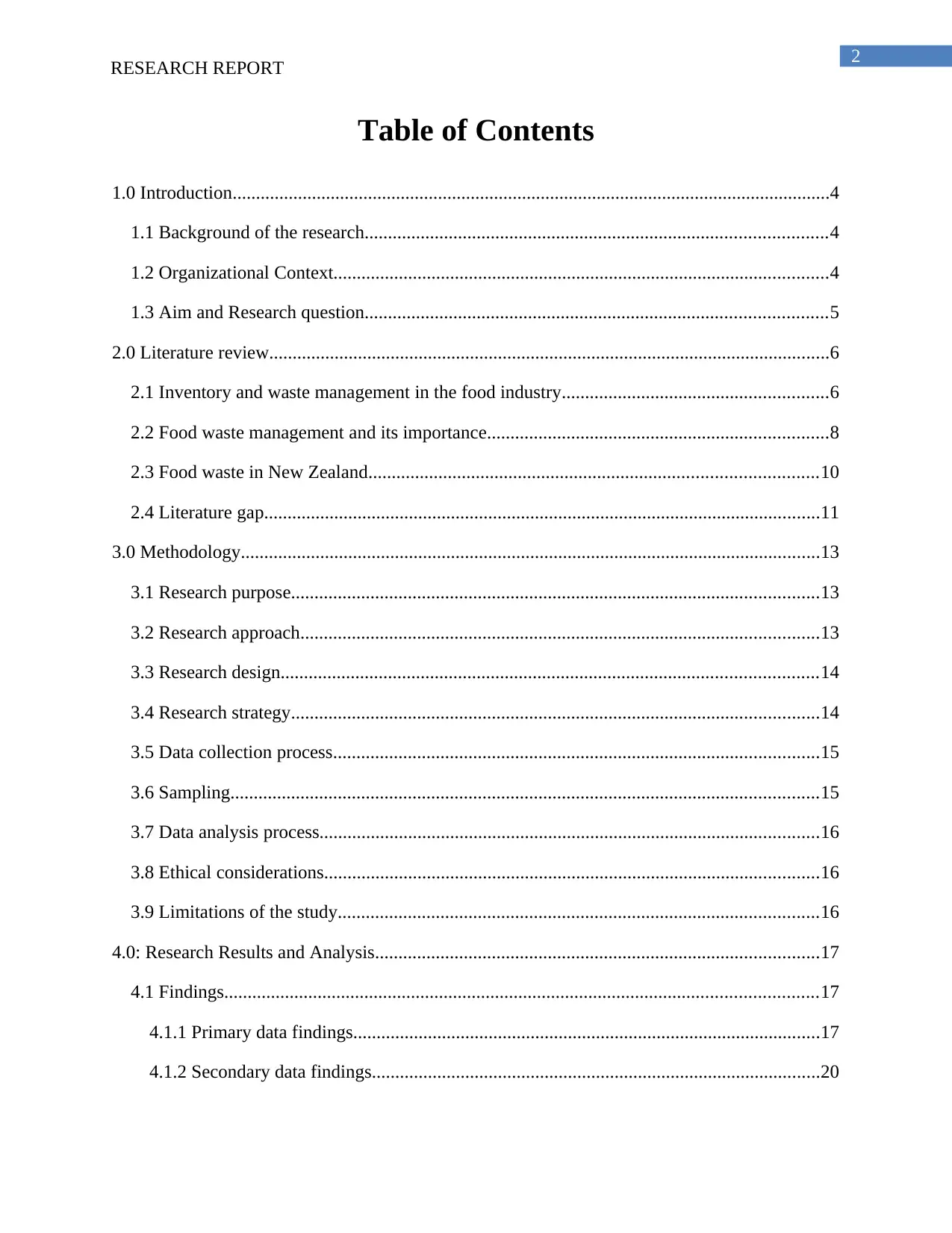
2
RESEARCH REPORT
Table of Contents
1.0 Introduction................................................................................................................................4
1.1 Background of the research...................................................................................................4
1.2 Organizational Context..........................................................................................................4
1.3 Aim and Research question...................................................................................................5
2.0 Literature review........................................................................................................................6
2.1 Inventory and waste management in the food industry.........................................................6
2.2 Food waste management and its importance.........................................................................8
2.3 Food waste in New Zealand................................................................................................10
2.4 Literature gap.......................................................................................................................11
3.0 Methodology............................................................................................................................13
3.1 Research purpose.................................................................................................................13
3.2 Research approach...............................................................................................................13
3.3 Research design...................................................................................................................14
3.4 Research strategy.................................................................................................................14
3.5 Data collection process........................................................................................................15
3.6 Sampling..............................................................................................................................15
3.7 Data analysis process...........................................................................................................16
3.8 Ethical considerations..........................................................................................................16
3.9 Limitations of the study.......................................................................................................16
4.0: Research Results and Analysis...............................................................................................17
4.1 Findings...............................................................................................................................17
4.1.1 Primary data findings....................................................................................................17
4.1.2 Secondary data findings................................................................................................20
RESEARCH REPORT
Table of Contents
1.0 Introduction................................................................................................................................4
1.1 Background of the research...................................................................................................4
1.2 Organizational Context..........................................................................................................4
1.3 Aim and Research question...................................................................................................5
2.0 Literature review........................................................................................................................6
2.1 Inventory and waste management in the food industry.........................................................6
2.2 Food waste management and its importance.........................................................................8
2.3 Food waste in New Zealand................................................................................................10
2.4 Literature gap.......................................................................................................................11
3.0 Methodology............................................................................................................................13
3.1 Research purpose.................................................................................................................13
3.2 Research approach...............................................................................................................13
3.3 Research design...................................................................................................................14
3.4 Research strategy.................................................................................................................14
3.5 Data collection process........................................................................................................15
3.6 Sampling..............................................................................................................................15
3.7 Data analysis process...........................................................................................................16
3.8 Ethical considerations..........................................................................................................16
3.9 Limitations of the study.......................................................................................................16
4.0: Research Results and Analysis...............................................................................................17
4.1 Findings...............................................................................................................................17
4.1.1 Primary data findings....................................................................................................17
4.1.2 Secondary data findings................................................................................................20
⊘ This is a preview!⊘
Do you want full access?
Subscribe today to unlock all pages.

Trusted by 1+ million students worldwide
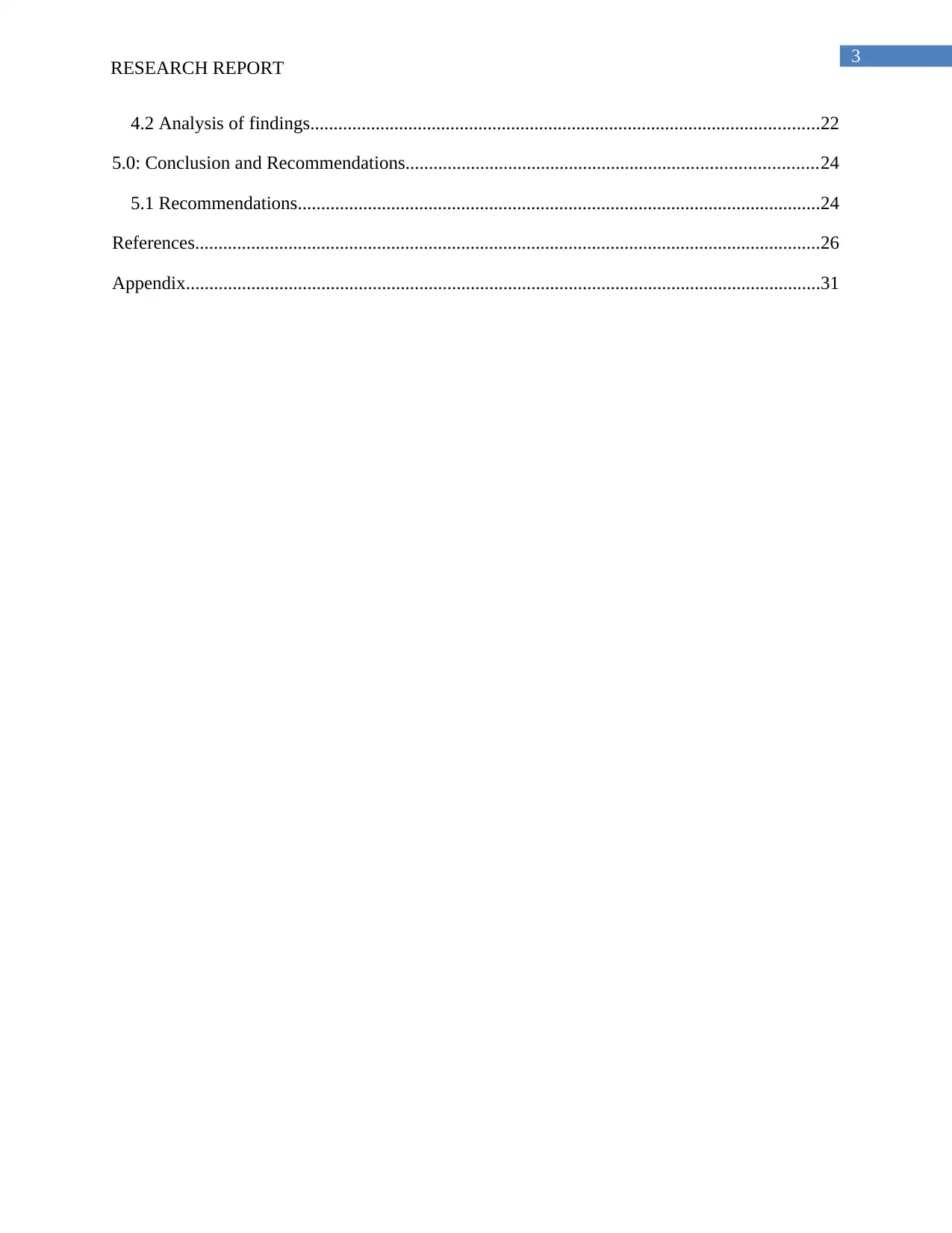
3
RESEARCH REPORT
4.2 Analysis of findings.............................................................................................................22
5.0: Conclusion and Recommendations........................................................................................24
5.1 Recommendations................................................................................................................24
References......................................................................................................................................26
Appendix........................................................................................................................................31
RESEARCH REPORT
4.2 Analysis of findings.............................................................................................................22
5.0: Conclusion and Recommendations........................................................................................24
5.1 Recommendations................................................................................................................24
References......................................................................................................................................26
Appendix........................................................................................................................................31
Paraphrase This Document
Need a fresh take? Get an instant paraphrase of this document with our AI Paraphraser

4
RESEARCH REPORT
1.0 Introduction
1.1 Background of the research
In the food and beverage industry, the role of inventory and waste management is highly
important. The stock of inventories and products is mostly perishable in the food companies and
thus, the processes of inventories and waste management are very different in this industry from
other industries handling large amount of inventories. The level of waste is also high in this
industry as the goods are perishable, which gives rise to the necessity of waste audit for the food
companies. Waste audit is a tool for regulating the usage of resources and inventories of the food
companies and this is important for keeping a check on the food wastage (Papargyropoulou et
al., 2016). This research report explores various aspects of inventory and waste management in
the context of a famous fast food restaurant in New Zealand. The level of food waste is generally
higher in the restaurant industry than in the household sector. Hence, to get an idea about the
issues in the inventory and waste management in the restaurant industry, the research was
conducted, and based on the findings some recommendations are provided to address the issues
and overcome the challenges. The features and effectiveness of waste audit were also explored as
an efficient measure of controlling the level of waste in the restaurants in order to assess its
potentiality to address the issue of inventory and waste management.
1.2 Organizational Context
In a time when a large percentage of the world’s population is suffering from food
insecurity, lack of adequate nutrition and hunger, wastage of food by the food companies as well
as by the customers appears to be a luxury not which every individual can afford (Gundersen &
Ziliak, 2015). Thus, in this awareness, the food companies are now adopting various measures
for regulating and controlling their food waste and resource waste as a part of the inventory and
waste management programmes, among which waste audit is one tool. This research proposal
aims to explore and evaluate the efficiency of waste audit system in implementing an efficient
inventory and waste management system in food companies which is beneficial for not only
reducing operational cost for the companies but also for reducing food waste. To conduct this
study, the researcher chose Subway, the world famous global chain of Submarine sandwiches
(Subs) and salads, operating in New Zealand. Similar to many other countries, New Zealand is
RESEARCH REPORT
1.0 Introduction
1.1 Background of the research
In the food and beverage industry, the role of inventory and waste management is highly
important. The stock of inventories and products is mostly perishable in the food companies and
thus, the processes of inventories and waste management are very different in this industry from
other industries handling large amount of inventories. The level of waste is also high in this
industry as the goods are perishable, which gives rise to the necessity of waste audit for the food
companies. Waste audit is a tool for regulating the usage of resources and inventories of the food
companies and this is important for keeping a check on the food wastage (Papargyropoulou et
al., 2016). This research report explores various aspects of inventory and waste management in
the context of a famous fast food restaurant in New Zealand. The level of food waste is generally
higher in the restaurant industry than in the household sector. Hence, to get an idea about the
issues in the inventory and waste management in the restaurant industry, the research was
conducted, and based on the findings some recommendations are provided to address the issues
and overcome the challenges. The features and effectiveness of waste audit were also explored as
an efficient measure of controlling the level of waste in the restaurants in order to assess its
potentiality to address the issue of inventory and waste management.
1.2 Organizational Context
In a time when a large percentage of the world’s population is suffering from food
insecurity, lack of adequate nutrition and hunger, wastage of food by the food companies as well
as by the customers appears to be a luxury not which every individual can afford (Gundersen &
Ziliak, 2015). Thus, in this awareness, the food companies are now adopting various measures
for regulating and controlling their food waste and resource waste as a part of the inventory and
waste management programmes, among which waste audit is one tool. This research proposal
aims to explore and evaluate the efficiency of waste audit system in implementing an efficient
inventory and waste management system in food companies which is beneficial for not only
reducing operational cost for the companies but also for reducing food waste. To conduct this
study, the researcher chose Subway, the world famous global chain of Submarine sandwiches
(Subs) and salads, operating in New Zealand. Similar to many other countries, New Zealand is
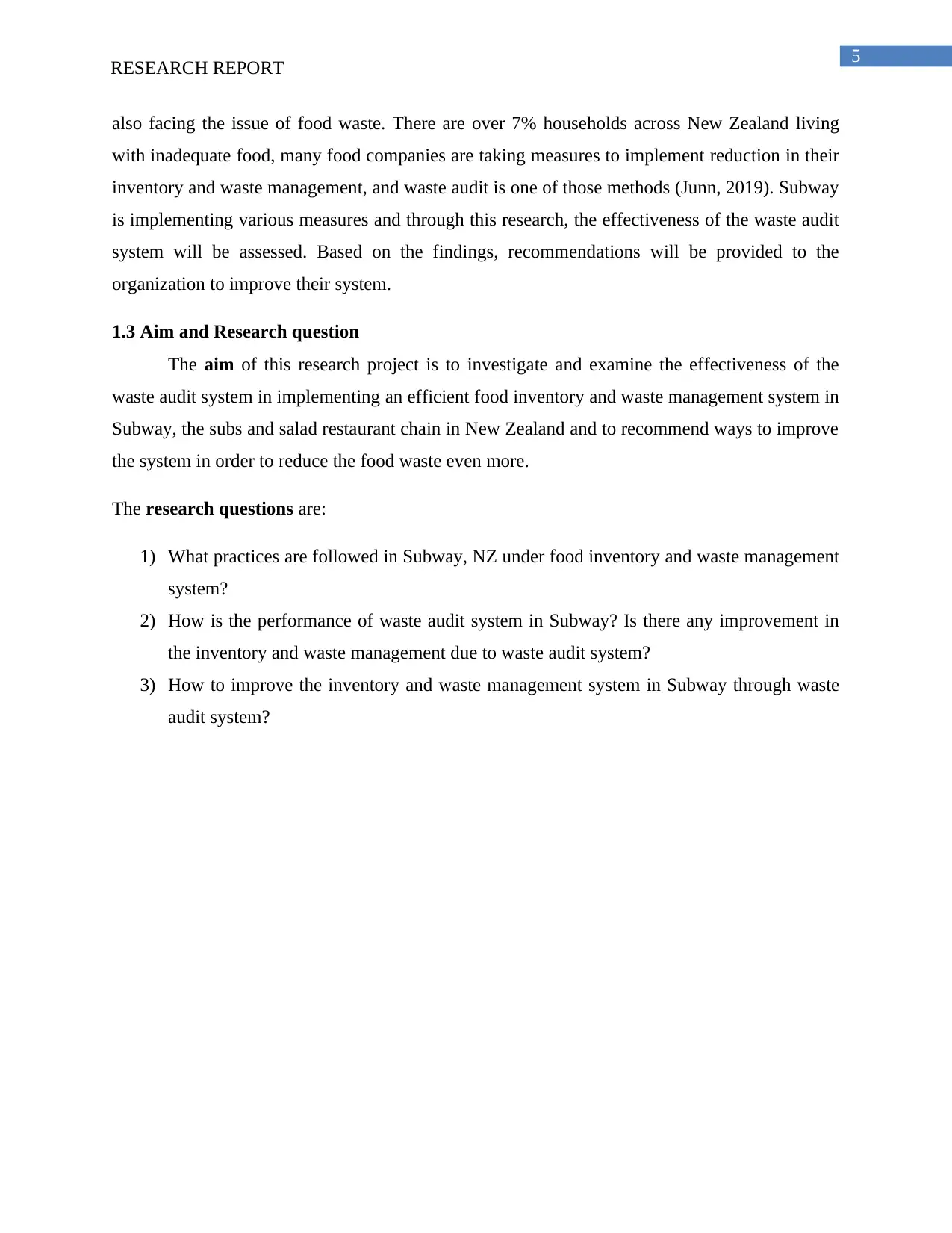
5
RESEARCH REPORT
also facing the issue of food waste. There are over 7% households across New Zealand living
with inadequate food, many food companies are taking measures to implement reduction in their
inventory and waste management, and waste audit is one of those methods (Junn, 2019). Subway
is implementing various measures and through this research, the effectiveness of the waste audit
system will be assessed. Based on the findings, recommendations will be provided to the
organization to improve their system.
1.3 Aim and Research question
The aim of this research project is to investigate and examine the effectiveness of the
waste audit system in implementing an efficient food inventory and waste management system in
Subway, the subs and salad restaurant chain in New Zealand and to recommend ways to improve
the system in order to reduce the food waste even more.
The research questions are:
1) What practices are followed in Subway, NZ under food inventory and waste management
system?
2) How is the performance of waste audit system in Subway? Is there any improvement in
the inventory and waste management due to waste audit system?
3) How to improve the inventory and waste management system in Subway through waste
audit system?
RESEARCH REPORT
also facing the issue of food waste. There are over 7% households across New Zealand living
with inadequate food, many food companies are taking measures to implement reduction in their
inventory and waste management, and waste audit is one of those methods (Junn, 2019). Subway
is implementing various measures and through this research, the effectiveness of the waste audit
system will be assessed. Based on the findings, recommendations will be provided to the
organization to improve their system.
1.3 Aim and Research question
The aim of this research project is to investigate and examine the effectiveness of the
waste audit system in implementing an efficient food inventory and waste management system in
Subway, the subs and salad restaurant chain in New Zealand and to recommend ways to improve
the system in order to reduce the food waste even more.
The research questions are:
1) What practices are followed in Subway, NZ under food inventory and waste management
system?
2) How is the performance of waste audit system in Subway? Is there any improvement in
the inventory and waste management due to waste audit system?
3) How to improve the inventory and waste management system in Subway through waste
audit system?
⊘ This is a preview!⊘
Do you want full access?
Subscribe today to unlock all pages.

Trusted by 1+ million students worldwide
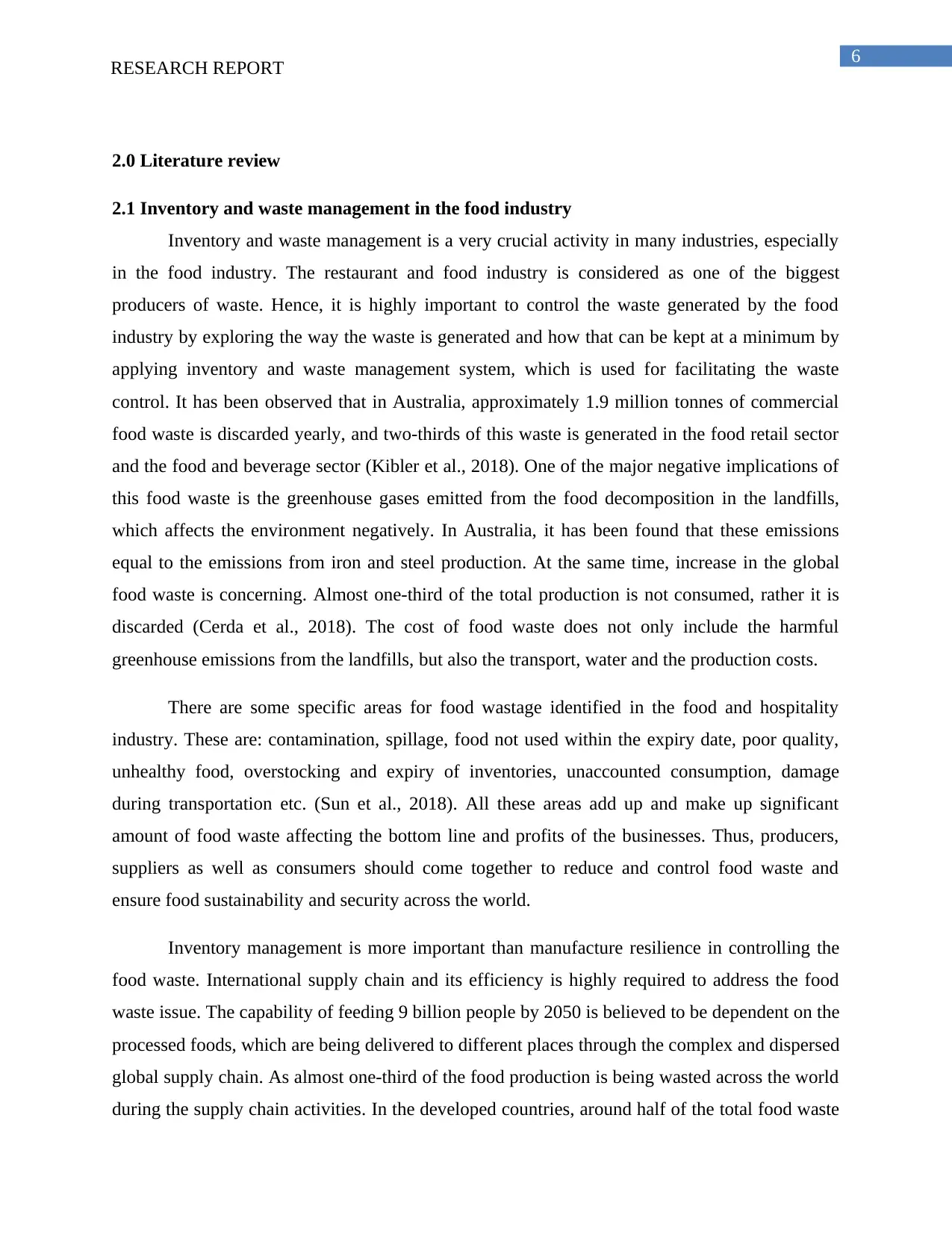
6
RESEARCH REPORT
2.0 Literature review
2.1 Inventory and waste management in the food industry
Inventory and waste management is a very crucial activity in many industries, especially
in the food industry. The restaurant and food industry is considered as one of the biggest
producers of waste. Hence, it is highly important to control the waste generated by the food
industry by exploring the way the waste is generated and how that can be kept at a minimum by
applying inventory and waste management system, which is used for facilitating the waste
control. It has been observed that in Australia, approximately 1.9 million tonnes of commercial
food waste is discarded yearly, and two-thirds of this waste is generated in the food retail sector
and the food and beverage sector (Kibler et al., 2018). One of the major negative implications of
this food waste is the greenhouse gases emitted from the food decomposition in the landfills,
which affects the environment negatively. In Australia, it has been found that these emissions
equal to the emissions from iron and steel production. At the same time, increase in the global
food waste is concerning. Almost one-third of the total production is not consumed, rather it is
discarded (Cerda et al., 2018). The cost of food waste does not only include the harmful
greenhouse emissions from the landfills, but also the transport, water and the production costs.
There are some specific areas for food wastage identified in the food and hospitality
industry. These are: contamination, spillage, food not used within the expiry date, poor quality,
unhealthy food, overstocking and expiry of inventories, unaccounted consumption, damage
during transportation etc. (Sun et al., 2018). All these areas add up and make up significant
amount of food waste affecting the bottom line and profits of the businesses. Thus, producers,
suppliers as well as consumers should come together to reduce and control food waste and
ensure food sustainability and security across the world.
Inventory management is more important than manufacture resilience in controlling the
food waste. International supply chain and its efficiency is highly required to address the food
waste issue. The capability of feeding 9 billion people by 2050 is believed to be dependent on the
processed foods, which are being delivered to different places through the complex and dispersed
global supply chain. As almost one-third of the food production is being wasted across the world
during the supply chain activities. In the developed countries, around half of the total food waste
RESEARCH REPORT
2.0 Literature review
2.1 Inventory and waste management in the food industry
Inventory and waste management is a very crucial activity in many industries, especially
in the food industry. The restaurant and food industry is considered as one of the biggest
producers of waste. Hence, it is highly important to control the waste generated by the food
industry by exploring the way the waste is generated and how that can be kept at a minimum by
applying inventory and waste management system, which is used for facilitating the waste
control. It has been observed that in Australia, approximately 1.9 million tonnes of commercial
food waste is discarded yearly, and two-thirds of this waste is generated in the food retail sector
and the food and beverage sector (Kibler et al., 2018). One of the major negative implications of
this food waste is the greenhouse gases emitted from the food decomposition in the landfills,
which affects the environment negatively. In Australia, it has been found that these emissions
equal to the emissions from iron and steel production. At the same time, increase in the global
food waste is concerning. Almost one-third of the total production is not consumed, rather it is
discarded (Cerda et al., 2018). The cost of food waste does not only include the harmful
greenhouse emissions from the landfills, but also the transport, water and the production costs.
There are some specific areas for food wastage identified in the food and hospitality
industry. These are: contamination, spillage, food not used within the expiry date, poor quality,
unhealthy food, overstocking and expiry of inventories, unaccounted consumption, damage
during transportation etc. (Sun et al., 2018). All these areas add up and make up significant
amount of food waste affecting the bottom line and profits of the businesses. Thus, producers,
suppliers as well as consumers should come together to reduce and control food waste and
ensure food sustainability and security across the world.
Inventory management is more important than manufacture resilience in controlling the
food waste. International supply chain and its efficiency is highly required to address the food
waste issue. The capability of feeding 9 billion people by 2050 is believed to be dependent on the
processed foods, which are being delivered to different places through the complex and dispersed
global supply chain. As almost one-third of the food production is being wasted across the world
during the supply chain activities. In the developed countries, around half of the total food waste
Paraphrase This Document
Need a fresh take? Get an instant paraphrase of this document with our AI Paraphraser
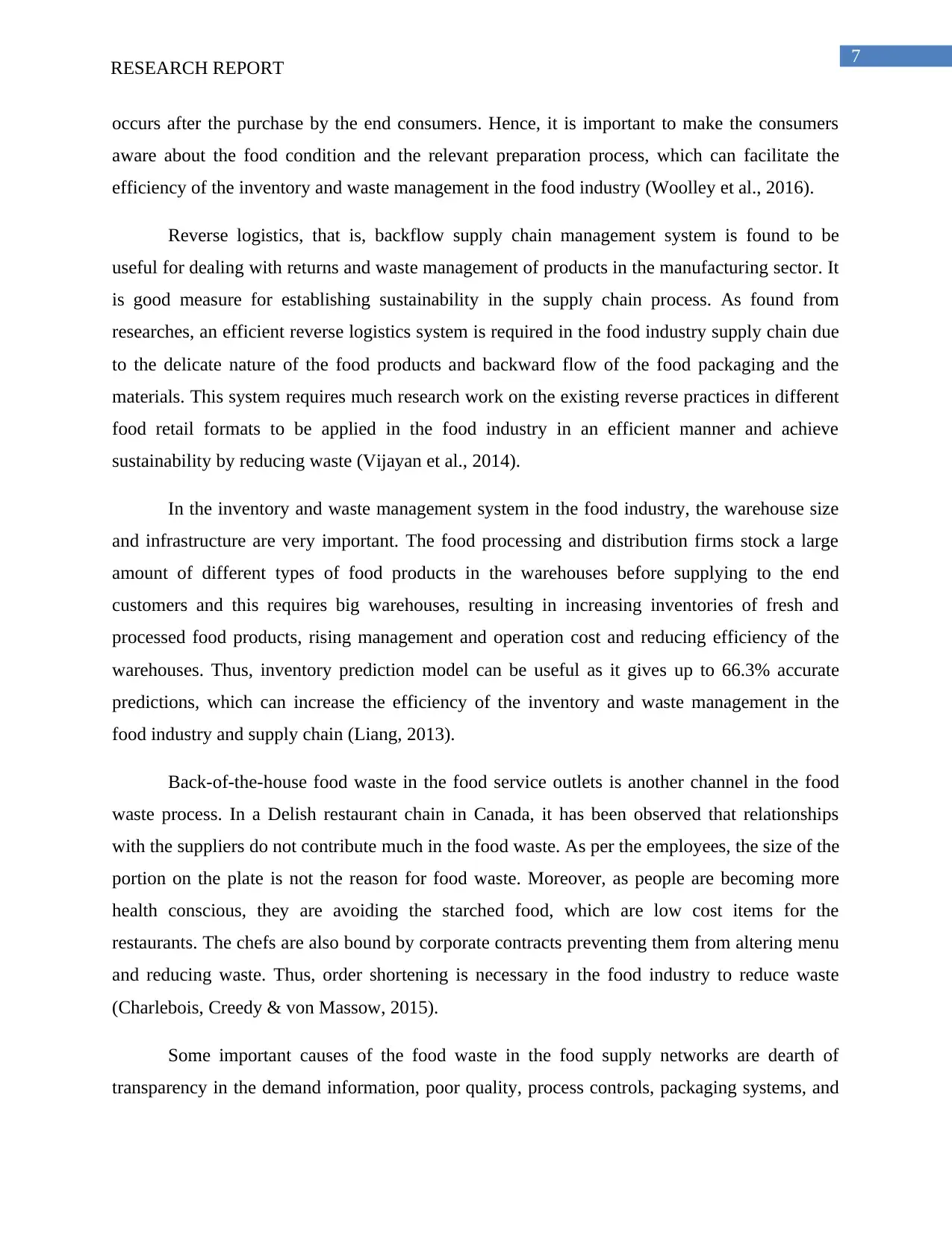
7
RESEARCH REPORT
occurs after the purchase by the end consumers. Hence, it is important to make the consumers
aware about the food condition and the relevant preparation process, which can facilitate the
efficiency of the inventory and waste management in the food industry (Woolley et al., 2016).
Reverse logistics, that is, backflow supply chain management system is found to be
useful for dealing with returns and waste management of products in the manufacturing sector. It
is good measure for establishing sustainability in the supply chain process. As found from
researches, an efficient reverse logistics system is required in the food industry supply chain due
to the delicate nature of the food products and backward flow of the food packaging and the
materials. This system requires much research work on the existing reverse practices in different
food retail formats to be applied in the food industry in an efficient manner and achieve
sustainability by reducing waste (Vijayan et al., 2014).
In the inventory and waste management system in the food industry, the warehouse size
and infrastructure are very important. The food processing and distribution firms stock a large
amount of different types of food products in the warehouses before supplying to the end
customers and this requires big warehouses, resulting in increasing inventories of fresh and
processed food products, rising management and operation cost and reducing efficiency of the
warehouses. Thus, inventory prediction model can be useful as it gives up to 66.3% accurate
predictions, which can increase the efficiency of the inventory and waste management in the
food industry and supply chain (Liang, 2013).
Back-of-the-house food waste in the food service outlets is another channel in the food
waste process. In a Delish restaurant chain in Canada, it has been observed that relationships
with the suppliers do not contribute much in the food waste. As per the employees, the size of the
portion on the plate is not the reason for food waste. Moreover, as people are becoming more
health conscious, they are avoiding the starched food, which are low cost items for the
restaurants. The chefs are also bound by corporate contracts preventing them from altering menu
and reducing waste. Thus, order shortening is necessary in the food industry to reduce waste
(Charlebois, Creedy & von Massow, 2015).
Some important causes of the food waste in the food supply networks are dearth of
transparency in the demand information, poor quality, process controls, packaging systems, and
RESEARCH REPORT
occurs after the purchase by the end consumers. Hence, it is important to make the consumers
aware about the food condition and the relevant preparation process, which can facilitate the
efficiency of the inventory and waste management in the food industry (Woolley et al., 2016).
Reverse logistics, that is, backflow supply chain management system is found to be
useful for dealing with returns and waste management of products in the manufacturing sector. It
is good measure for establishing sustainability in the supply chain process. As found from
researches, an efficient reverse logistics system is required in the food industry supply chain due
to the delicate nature of the food products and backward flow of the food packaging and the
materials. This system requires much research work on the existing reverse practices in different
food retail formats to be applied in the food industry in an efficient manner and achieve
sustainability by reducing waste (Vijayan et al., 2014).
In the inventory and waste management system in the food industry, the warehouse size
and infrastructure are very important. The food processing and distribution firms stock a large
amount of different types of food products in the warehouses before supplying to the end
customers and this requires big warehouses, resulting in increasing inventories of fresh and
processed food products, rising management and operation cost and reducing efficiency of the
warehouses. Thus, inventory prediction model can be useful as it gives up to 66.3% accurate
predictions, which can increase the efficiency of the inventory and waste management in the
food industry and supply chain (Liang, 2013).
Back-of-the-house food waste in the food service outlets is another channel in the food
waste process. In a Delish restaurant chain in Canada, it has been observed that relationships
with the suppliers do not contribute much in the food waste. As per the employees, the size of the
portion on the plate is not the reason for food waste. Moreover, as people are becoming more
health conscious, they are avoiding the starched food, which are low cost items for the
restaurants. The chefs are also bound by corporate contracts preventing them from altering menu
and reducing waste. Thus, order shortening is necessary in the food industry to reduce waste
(Charlebois, Creedy & von Massow, 2015).
Some important causes of the food waste in the food supply networks are dearth of
transparency in the demand information, poor quality, process controls, packaging systems, and
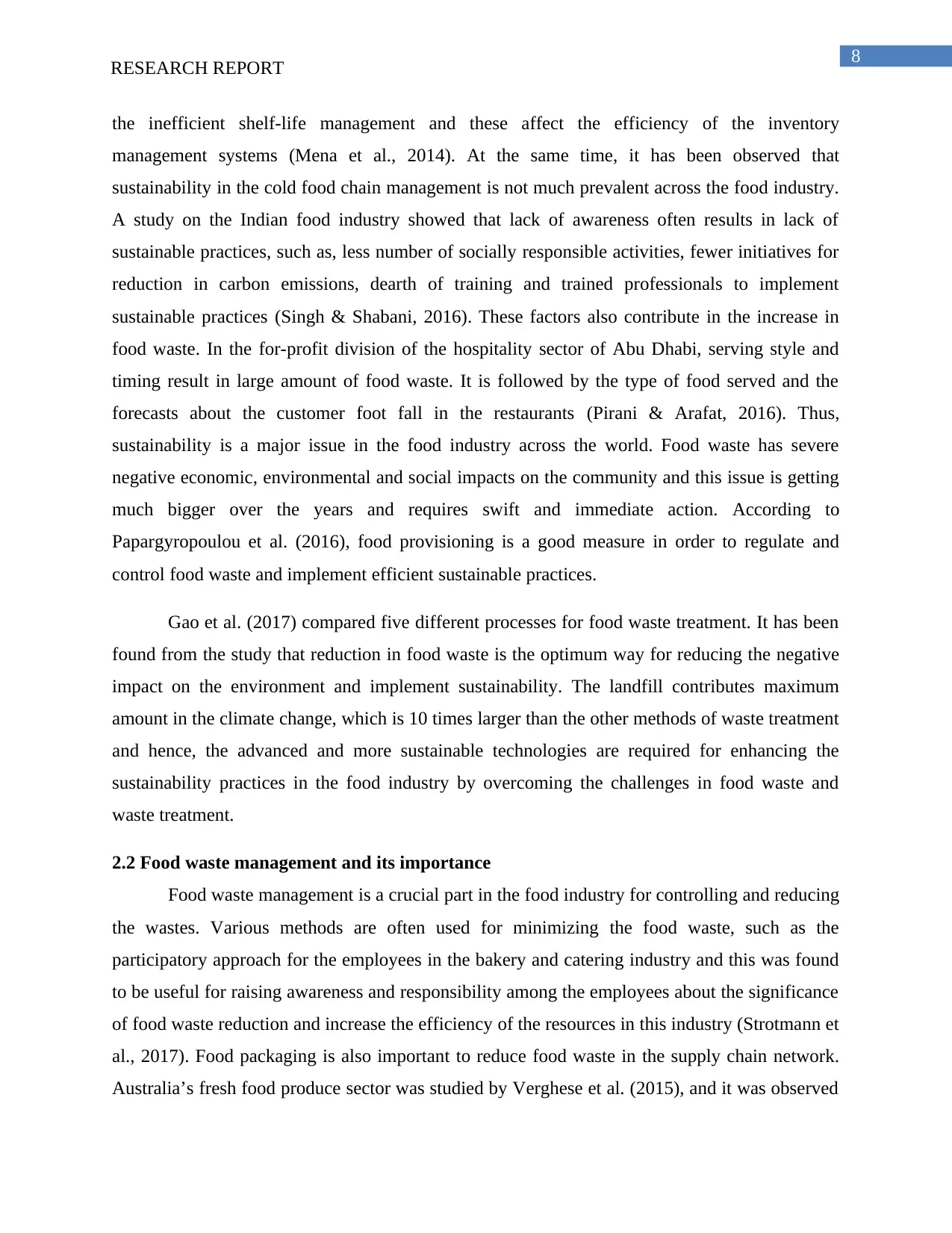
8
RESEARCH REPORT
the inefficient shelf-life management and these affect the efficiency of the inventory
management systems (Mena et al., 2014). At the same time, it has been observed that
sustainability in the cold food chain management is not much prevalent across the food industry.
A study on the Indian food industry showed that lack of awareness often results in lack of
sustainable practices, such as, less number of socially responsible activities, fewer initiatives for
reduction in carbon emissions, dearth of training and trained professionals to implement
sustainable practices (Singh & Shabani, 2016). These factors also contribute in the increase in
food waste. In the for-profit division of the hospitality sector of Abu Dhabi, serving style and
timing result in large amount of food waste. It is followed by the type of food served and the
forecasts about the customer foot fall in the restaurants (Pirani & Arafat, 2016). Thus,
sustainability is a major issue in the food industry across the world. Food waste has severe
negative economic, environmental and social impacts on the community and this issue is getting
much bigger over the years and requires swift and immediate action. According to
Papargyropoulou et al. (2016), food provisioning is a good measure in order to regulate and
control food waste and implement efficient sustainable practices.
Gao et al. (2017) compared five different processes for food waste treatment. It has been
found from the study that reduction in food waste is the optimum way for reducing the negative
impact on the environment and implement sustainability. The landfill contributes maximum
amount in the climate change, which is 10 times larger than the other methods of waste treatment
and hence, the advanced and more sustainable technologies are required for enhancing the
sustainability practices in the food industry by overcoming the challenges in food waste and
waste treatment.
2.2 Food waste management and its importance
Food waste management is a crucial part in the food industry for controlling and reducing
the wastes. Various methods are often used for minimizing the food waste, such as the
participatory approach for the employees in the bakery and catering industry and this was found
to be useful for raising awareness and responsibility among the employees about the significance
of food waste reduction and increase the efficiency of the resources in this industry (Strotmann et
al., 2017). Food packaging is also important to reduce food waste in the supply chain network.
Australia’s fresh food produce sector was studied by Verghese et al. (2015), and it was observed
RESEARCH REPORT
the inefficient shelf-life management and these affect the efficiency of the inventory
management systems (Mena et al., 2014). At the same time, it has been observed that
sustainability in the cold food chain management is not much prevalent across the food industry.
A study on the Indian food industry showed that lack of awareness often results in lack of
sustainable practices, such as, less number of socially responsible activities, fewer initiatives for
reduction in carbon emissions, dearth of training and trained professionals to implement
sustainable practices (Singh & Shabani, 2016). These factors also contribute in the increase in
food waste. In the for-profit division of the hospitality sector of Abu Dhabi, serving style and
timing result in large amount of food waste. It is followed by the type of food served and the
forecasts about the customer foot fall in the restaurants (Pirani & Arafat, 2016). Thus,
sustainability is a major issue in the food industry across the world. Food waste has severe
negative economic, environmental and social impacts on the community and this issue is getting
much bigger over the years and requires swift and immediate action. According to
Papargyropoulou et al. (2016), food provisioning is a good measure in order to regulate and
control food waste and implement efficient sustainable practices.
Gao et al. (2017) compared five different processes for food waste treatment. It has been
found from the study that reduction in food waste is the optimum way for reducing the negative
impact on the environment and implement sustainability. The landfill contributes maximum
amount in the climate change, which is 10 times larger than the other methods of waste treatment
and hence, the advanced and more sustainable technologies are required for enhancing the
sustainability practices in the food industry by overcoming the challenges in food waste and
waste treatment.
2.2 Food waste management and its importance
Food waste management is a crucial part in the food industry for controlling and reducing
the wastes. Various methods are often used for minimizing the food waste, such as the
participatory approach for the employees in the bakery and catering industry and this was found
to be useful for raising awareness and responsibility among the employees about the significance
of food waste reduction and increase the efficiency of the resources in this industry (Strotmann et
al., 2017). Food packaging is also important to reduce food waste in the supply chain network.
Australia’s fresh food produce sector was studied by Verghese et al. (2015), and it was observed
⊘ This is a preview!⊘
Do you want full access?
Subscribe today to unlock all pages.

Trusted by 1+ million students worldwide
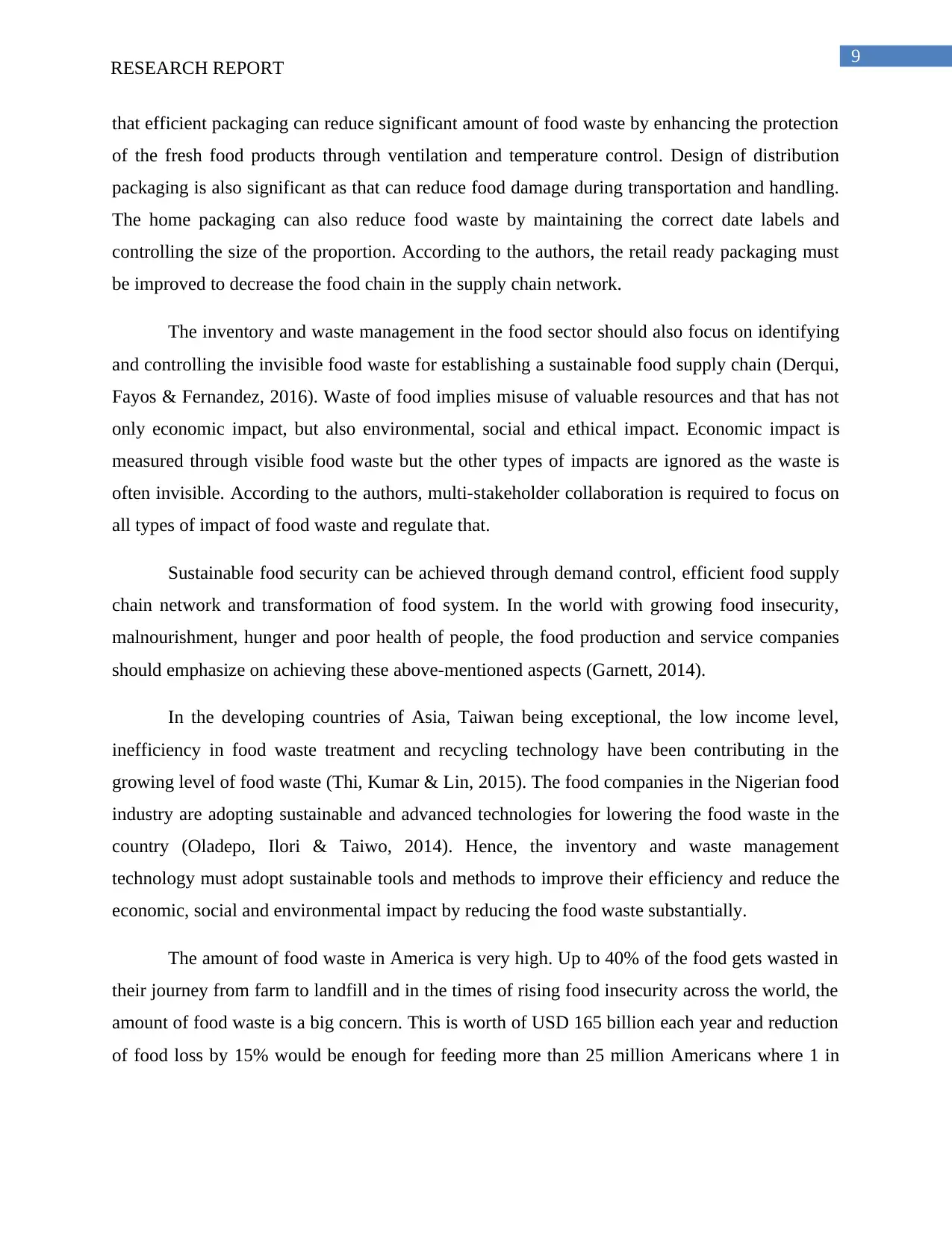
9
RESEARCH REPORT
that efficient packaging can reduce significant amount of food waste by enhancing the protection
of the fresh food products through ventilation and temperature control. Design of distribution
packaging is also significant as that can reduce food damage during transportation and handling.
The home packaging can also reduce food waste by maintaining the correct date labels and
controlling the size of the proportion. According to the authors, the retail ready packaging must
be improved to decrease the food chain in the supply chain network.
The inventory and waste management in the food sector should also focus on identifying
and controlling the invisible food waste for establishing a sustainable food supply chain (Derqui,
Fayos & Fernandez, 2016). Waste of food implies misuse of valuable resources and that has not
only economic impact, but also environmental, social and ethical impact. Economic impact is
measured through visible food waste but the other types of impacts are ignored as the waste is
often invisible. According to the authors, multi-stakeholder collaboration is required to focus on
all types of impact of food waste and regulate that.
Sustainable food security can be achieved through demand control, efficient food supply
chain network and transformation of food system. In the world with growing food insecurity,
malnourishment, hunger and poor health of people, the food production and service companies
should emphasize on achieving these above-mentioned aspects (Garnett, 2014).
In the developing countries of Asia, Taiwan being exceptional, the low income level,
inefficiency in food waste treatment and recycling technology have been contributing in the
growing level of food waste (Thi, Kumar & Lin, 2015). The food companies in the Nigerian food
industry are adopting sustainable and advanced technologies for lowering the food waste in the
country (Oladepo, Ilori & Taiwo, 2014). Hence, the inventory and waste management
technology must adopt sustainable tools and methods to improve their efficiency and reduce the
economic, social and environmental impact by reducing the food waste substantially.
The amount of food waste in America is very high. Up to 40% of the food gets wasted in
their journey from farm to landfill and in the times of rising food insecurity across the world, the
amount of food waste is a big concern. This is worth of USD 165 billion each year and reduction
of food loss by 15% would be enough for feeding more than 25 million Americans where 1 in
RESEARCH REPORT
that efficient packaging can reduce significant amount of food waste by enhancing the protection
of the fresh food products through ventilation and temperature control. Design of distribution
packaging is also significant as that can reduce food damage during transportation and handling.
The home packaging can also reduce food waste by maintaining the correct date labels and
controlling the size of the proportion. According to the authors, the retail ready packaging must
be improved to decrease the food chain in the supply chain network.
The inventory and waste management in the food sector should also focus on identifying
and controlling the invisible food waste for establishing a sustainable food supply chain (Derqui,
Fayos & Fernandez, 2016). Waste of food implies misuse of valuable resources and that has not
only economic impact, but also environmental, social and ethical impact. Economic impact is
measured through visible food waste but the other types of impacts are ignored as the waste is
often invisible. According to the authors, multi-stakeholder collaboration is required to focus on
all types of impact of food waste and regulate that.
Sustainable food security can be achieved through demand control, efficient food supply
chain network and transformation of food system. In the world with growing food insecurity,
malnourishment, hunger and poor health of people, the food production and service companies
should emphasize on achieving these above-mentioned aspects (Garnett, 2014).
In the developing countries of Asia, Taiwan being exceptional, the low income level,
inefficiency in food waste treatment and recycling technology have been contributing in the
growing level of food waste (Thi, Kumar & Lin, 2015). The food companies in the Nigerian food
industry are adopting sustainable and advanced technologies for lowering the food waste in the
country (Oladepo, Ilori & Taiwo, 2014). Hence, the inventory and waste management
technology must adopt sustainable tools and methods to improve their efficiency and reduce the
economic, social and environmental impact by reducing the food waste substantially.
The amount of food waste in America is very high. Up to 40% of the food gets wasted in
their journey from farm to landfill and in the times of rising food insecurity across the world, the
amount of food waste is a big concern. This is worth of USD 165 billion each year and reduction
of food loss by 15% would be enough for feeding more than 25 million Americans where 1 in
Paraphrase This Document
Need a fresh take? Get an instant paraphrase of this document with our AI Paraphraser
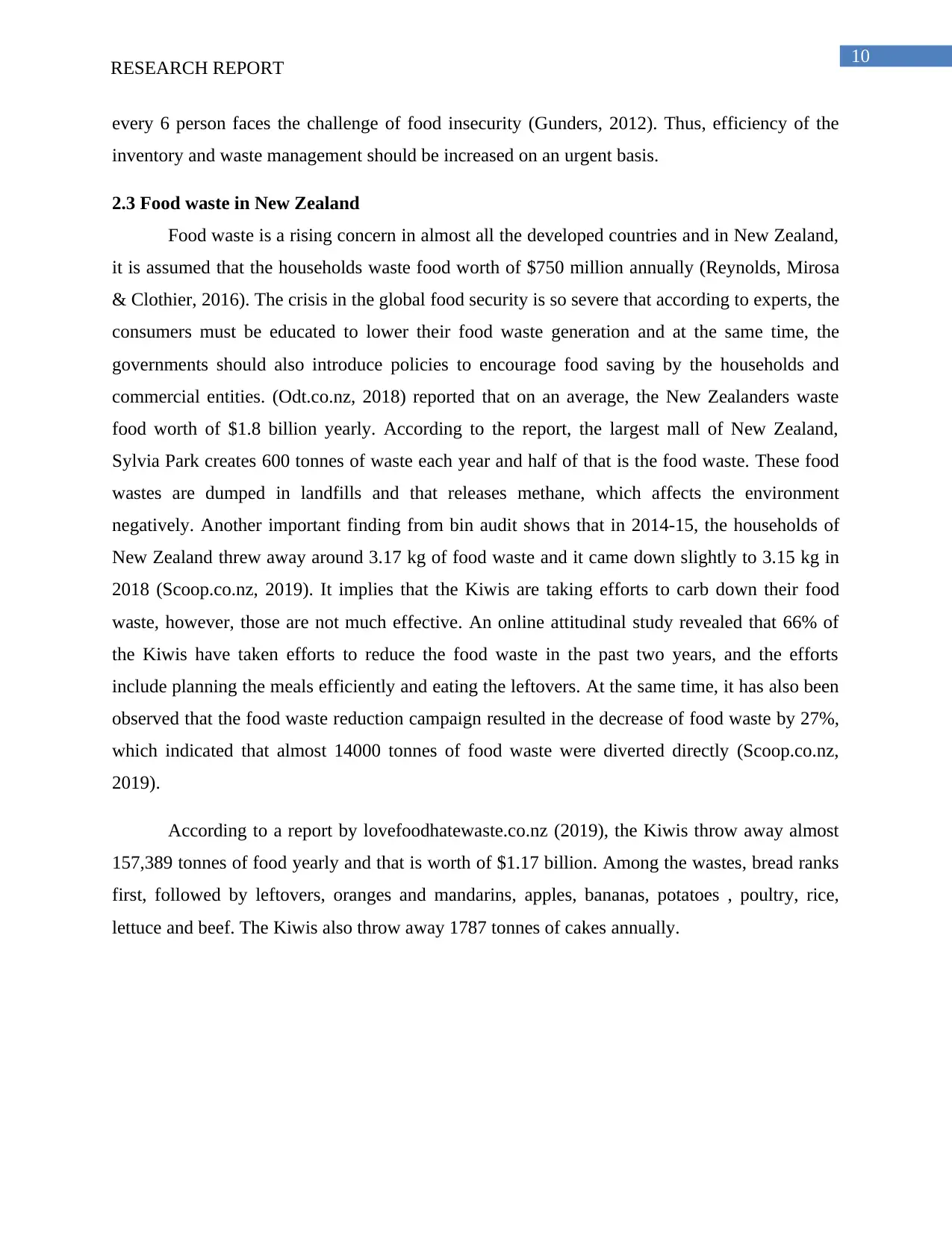
10
RESEARCH REPORT
every 6 person faces the challenge of food insecurity (Gunders, 2012). Thus, efficiency of the
inventory and waste management should be increased on an urgent basis.
2.3 Food waste in New Zealand
Food waste is a rising concern in almost all the developed countries and in New Zealand,
it is assumed that the households waste food worth of $750 million annually (Reynolds, Mirosa
& Clothier, 2016). The crisis in the global food security is so severe that according to experts, the
consumers must be educated to lower their food waste generation and at the same time, the
governments should also introduce policies to encourage food saving by the households and
commercial entities. (Odt.co.nz, 2018) reported that on an average, the New Zealanders waste
food worth of $1.8 billion yearly. According to the report, the largest mall of New Zealand,
Sylvia Park creates 600 tonnes of waste each year and half of that is the food waste. These food
wastes are dumped in landfills and that releases methane, which affects the environment
negatively. Another important finding from bin audit shows that in 2014-15, the households of
New Zealand threw away around 3.17 kg of food waste and it came down slightly to 3.15 kg in
2018 (Scoop.co.nz, 2019). It implies that the Kiwis are taking efforts to carb down their food
waste, however, those are not much effective. An online attitudinal study revealed that 66% of
the Kiwis have taken efforts to reduce the food waste in the past two years, and the efforts
include planning the meals efficiently and eating the leftovers. At the same time, it has also been
observed that the food waste reduction campaign resulted in the decrease of food waste by 27%,
which indicated that almost 14000 tonnes of food waste were diverted directly (Scoop.co.nz,
2019).
According to a report by lovefoodhatewaste.co.nz (2019), the Kiwis throw away almost
157,389 tonnes of food yearly and that is worth of $1.17 billion. Among the wastes, bread ranks
first, followed by leftovers, oranges and mandarins, apples, bananas, potatoes , poultry, rice,
lettuce and beef. The Kiwis also throw away 1787 tonnes of cakes annually.
RESEARCH REPORT
every 6 person faces the challenge of food insecurity (Gunders, 2012). Thus, efficiency of the
inventory and waste management should be increased on an urgent basis.
2.3 Food waste in New Zealand
Food waste is a rising concern in almost all the developed countries and in New Zealand,
it is assumed that the households waste food worth of $750 million annually (Reynolds, Mirosa
& Clothier, 2016). The crisis in the global food security is so severe that according to experts, the
consumers must be educated to lower their food waste generation and at the same time, the
governments should also introduce policies to encourage food saving by the households and
commercial entities. (Odt.co.nz, 2018) reported that on an average, the New Zealanders waste
food worth of $1.8 billion yearly. According to the report, the largest mall of New Zealand,
Sylvia Park creates 600 tonnes of waste each year and half of that is the food waste. These food
wastes are dumped in landfills and that releases methane, which affects the environment
negatively. Another important finding from bin audit shows that in 2014-15, the households of
New Zealand threw away around 3.17 kg of food waste and it came down slightly to 3.15 kg in
2018 (Scoop.co.nz, 2019). It implies that the Kiwis are taking efforts to carb down their food
waste, however, those are not much effective. An online attitudinal study revealed that 66% of
the Kiwis have taken efforts to reduce the food waste in the past two years, and the efforts
include planning the meals efficiently and eating the leftovers. At the same time, it has also been
observed that the food waste reduction campaign resulted in the decrease of food waste by 27%,
which indicated that almost 14000 tonnes of food waste were diverted directly (Scoop.co.nz,
2019).
According to a report by lovefoodhatewaste.co.nz (2019), the Kiwis throw away almost
157,389 tonnes of food yearly and that is worth of $1.17 billion. Among the wastes, bread ranks
first, followed by leftovers, oranges and mandarins, apples, bananas, potatoes , poultry, rice,
lettuce and beef. The Kiwis also throw away 1787 tonnes of cakes annually.

11
RESEARCH REPORT
Figure 1: Top 10 avoidable food types that are wasted in New Zealand
(Source: lovefoodhatewaste.co.nz, 2019)
The Parliament of New Zealand has considered the food waste as a serious matter of concern and
they are taking measures to reduce that. The Environment Committee has been appointed to
explore the issues like the food waste problem, preventing and redistributing food waste
(Parliament.nz, 2018).
2.4 Literature gap
From the above discussion, it can be said that various studies have been conducted to
explore the efficiency and scopes of the inventory and waste management in the food industry
and different measures to reduce the level of waste and achieve sustainability. However, no study
RESEARCH REPORT
Figure 1: Top 10 avoidable food types that are wasted in New Zealand
(Source: lovefoodhatewaste.co.nz, 2019)
The Parliament of New Zealand has considered the food waste as a serious matter of concern and
they are taking measures to reduce that. The Environment Committee has been appointed to
explore the issues like the food waste problem, preventing and redistributing food waste
(Parliament.nz, 2018).
2.4 Literature gap
From the above discussion, it can be said that various studies have been conducted to
explore the efficiency and scopes of the inventory and waste management in the food industry
and different measures to reduce the level of waste and achieve sustainability. However, no study
⊘ This is a preview!⊘
Do you want full access?
Subscribe today to unlock all pages.

Trusted by 1+ million students worldwide
1 out of 34
Related Documents
Your All-in-One AI-Powered Toolkit for Academic Success.
+13062052269
info@desklib.com
Available 24*7 on WhatsApp / Email
![[object Object]](/_next/static/media/star-bottom.7253800d.svg)
Unlock your academic potential
Copyright © 2020–2025 A2Z Services. All Rights Reserved. Developed and managed by ZUCOL.





